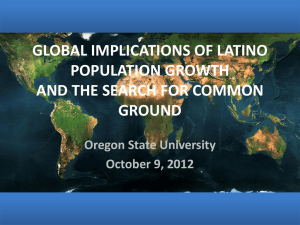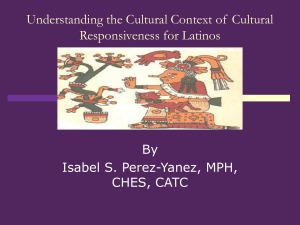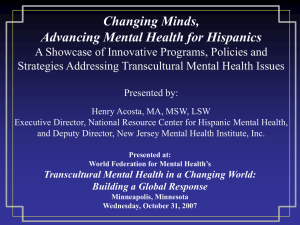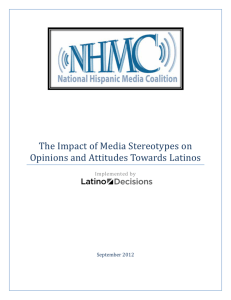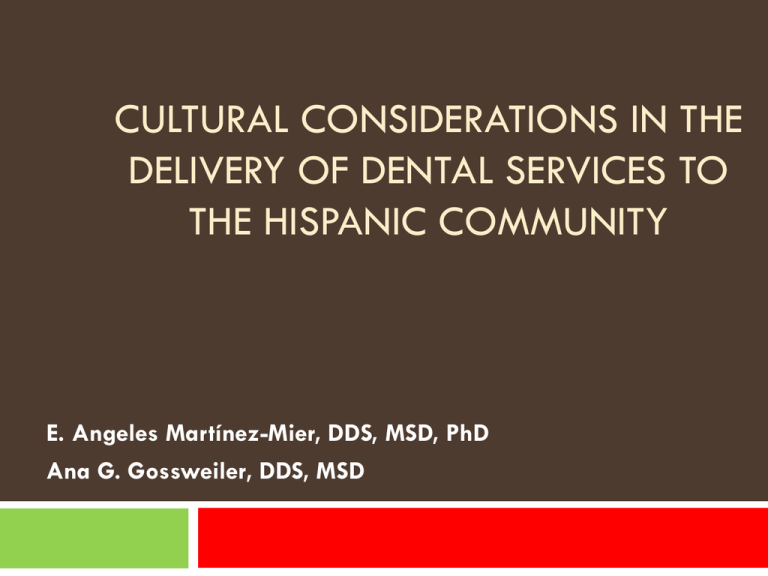
CULTURAL CONSIDERATIONS IN THE
DELIVERY OF DENTAL SERVICES TO
THE HISPANIC COMMUNITY
E. Angeles Martínez-Mier, DDS, MSD, PhD
Ana G. Gossweiler, DDS, MSD
U.S. Demographics
Rapidly becoming more diverse
Minority populations growing at a fast pace
Hispanic group becoming the largest minority
group in the U.S.
Indiana Demographics
Population has tripled between 1990 and 2002
Mexicans
60%
Median age 25
13% of the population in Indiana
Indianapolis
studies
65 000 to 85 0000 according to local
Hispanics or Latinos in Indiana
Hispanics or Latinos of any race
214,536
Mexican
Puerto Rican
Cuban
Others
153,042
19,678
2,754
39,062
U.S. Census Bureau, Census 2000
Culture
What is it?
Where is it found?
Who has it?
When is it used?
Why is it important?
Culture
The skills, art, etc., of a given people in
a given period, civilization
Webster’s New World Dictionary
Culture
Culture is:
Guides
how people live
What they believe and value
How they communicate
What are their habits, customs and tastes
Guides the ways they meet various needs of society
How goods and services are produced and distributed
Slide by Valery Yontz, PhD, University of Hawaii
Definitions
Cross-cultural
Intercultural
Subculture
Values
Beliefs
Stereotyping
Ethnocentrism
Cross-cultural
Refers to any comparison of cultural
differences or the situations in which such
differences exist
Intercultural
Refers to the actual interaction between
people of different cultures
Subculture
Formed by a group of persons who have
developed interests or goals different
from the primary culture, based on such
things as occupation, sex, age, social
class, or religion.
Values
Ideas about what is right and wrong,
desirable and undesirable, normal and
abnormal, proper and improper
A set of organized rules for making choices,
reducing uncertainty and reducing conflicts
within a given society
Beliefs
Belief is a psychological state in which an
individual holds a premise or an argument
to be true without necessarily being able
to adequately prove their point to other
people who may or may not agree.
Stereotyping
Refers to the common behavior of assuming that
individuals possess certain characteristics or traits
because they are members of a particular group.
Fails to recognize the individual
Ethnocentrism
Natural belief that one’s culture is superior to
that of others
Care is needed not to demean clients whose
oral health practices may be rooted in culture
rather than scientific fact
Iceberg Concept
Is the culture always visible to the observer?
Primarily in Awareness
Primarily out of Awareness
Primarily in Awareness
May be obvious to the observer
Fine arts
Literature
Drama
Music
Dancing
Games
Cooking
Dress
Primarily Out of Awareness
Not necessarily obvious to the observer
Notions of modesty
Conceptions of beauty
Patterns for handling emotions
Conception of self
Conception of justice
Decision making patterns
Attitudes toward the dependent
Patterns of superior/subordinate relationship
Health Care Issues Related to Culture
Culture influences:
- communication (language, tone, nonverbal
communication)
- trust
- behavior
- understanding wellness and illness
- seeking health care
- receiving and complying with care
Cultural Competency’s Definition
The ongoing process of actively developing and
practicing appropriate, relevant, and sensitive
strategies and skills in interacting with culturally
different people. Includes the capacity to respond
appropriately to the needs of populations whose
cultures are different from what might be “the
dominant or mainstream culture.”
Slide by Valery Yontz, PhD, University of Hawaii
Goals of Cultural Competency
Self- exploration
Personal development
Attitude and values clarification
Ethnic and cultural literacy
Empowerment—equality and excellence
Basic skills proficiency
Social competency
Slide by Valery Yontz, PhD, University of Hawaii
Skills and Characteristics of Cultural
Competency
Respectful
Willingness to share, risk change,& explore
Understand the power of action and words
Ability to recognize learning opportunities
Possessing knowledge of one’s self
Being aware of ignorance
Having attitude that “Different is okay: not good or
bad
Slide by Valery Yontz, PhD, University of Hawaii
Right or Wrong
“We must be able to recognize and deal with
beliefs of others if we wish to obtain
communication.”
Samovar & Porter
Intercultural Communication
Good
Bad
http://www.yourpointofview.com/
Bad
Good
http://www.yourpointofview.com/
Cultural Competency Components
Develop an awareness of one’s own existence
Demonstrate knowledge and understanding of other
cultures
Accepting/respecting cultural differences
Stop assuming that others’ beliefs and values are the
same as yours
Stop judging attitudes as good or bad
Be open to range of cultural encounters
Adapt to be congruent with other cultured persons
Slide by Valery Yontz, PhD, University of Hawaii
Cross’s Cultural Competency Continuum
Cultural
destructiveness
Cultural incapacity
Cultural blindness
Cultural pre-competence
Cultural competence
Cultural proficiency
Slide by Valery Yontz, PhD, University of Hawaii
Cross, T; 2001
Why is cultural competence
important to dental professionals?
It assist in recognizing the elements
of culture that are relevant during a
patient care (communication issues,
religion, family networks, gender
norms, sense of humor, etc…)
Benefits of gaining intercultural
competence
Provide compatible messages with patient’s cultural
values and beliefs
Increase the relevancy of health education
Increase effectiveness of dental care with a diverse
client
Increase a practitioner’s multicultural knowledge
Cultural Assessment Domains
Ethnic identity/history
Communication
Activities of daily living
Orientation to time
Food practices
Family relationships
Birth and death rituals
Spiritual/religious orientation
Bio-cultural ecology
Illness beliefs
High-risk behaviors
Health practices and practitioners
Slide by Valery Yontz, PhD, University of Hawaii
Hispanics/Latinos: Key Cultural Points
Ethnic Identity and History
Latin America designates all those countries and territories in the
Americas where languages derived from Latin are spoken: Spanish,
Portuguese, French, and their creoles.
The region was home to many indigenous peoples and advanced
civilizations (Aztecs, Mayan, and Incas). With the arrival of the
Europeans the indigenous peoples lost power to the Europeans. European
powers, most notably Spain and Portugal, colonized the region. After
independence movements, the countries of the region became
independent by the late 19th century.
Diversity within the Hispanic Community
People in Latin America are
a mixture of many racial
groups.
Their origins include over 22
countries
While Spanish is usually the
common language, there is a
wide variety of idiomatic
speech patterns and dialects
Diversity = Mix of Cultures
Hispanics/Latinos: Key Cultural Points
Communication
Casual conversation prior to “the point”
Resistance to lose language
Maintain outward expressions of dignity and calm
Touching, kissing, hugging between family in public
Make eye contact, hold hands, hug
Hispanics/Latinos: Key Cultural Points
Activities of Daily Living (ADLs)
Respect for tradition
Hard working
Follow cultural/family practices, cleaning, cooking, etc.
(practice of traditional things in the U.S.)
Collectivism
Latinos prefer the company of others versus being
alone.
Sharing is an activity that is an outgrowth of
collectivism.
Drinking alcohol and smoking are experiences that
are shared with other friends.
How long a man drinks with his friends is often determined
by when his wife arrives to tell him it is time to come home.
Chong, The Latino Patient
Hispanics/Latinos: Key Cultural Points
Orientation to Time
Flexible sense of time
Food Practices
Very traditional
Special events
Family traditions
Hispanics/Latinos: Key Cultural Points
Family Relationships
Connectedness to extended family
Children taught to repress aggressive and assertive
behavior
Machismo/Marianismo
Cultural values and gender
Machismo
refers
to the man’s masculinity and puts the man
at the center of the social life. It is exhibited
through courage and authoritarian attitude
Marianismo
Refers
to the woman’s position at home and in the
family. A woman earns respect through her
dedication to her children and husband
Cultural values and gender
As the need for income increases, there is
greater financial pressure on the wife to enter
the workforce.
As she contributes to the family income, she will
attain more independence and greater parity
in the family decision making process.
Her exposure to the workplace and her social
contacts outside the home will tend to
accelerate the process of acculturation.
Hispanics/Latinos: Key Cultural Points
Birth and Death Rituals
Male/Female
roles well defined during funeral and
births
Women pampered more during pregnancy
Cultural traditions practiced at funerals
Hispanics/Latinos: Key Cultural Points
Spiritual and Religious Orientation
Catholics
Some develop special relationships with saints
Some superstitions
Sacrifice in the world is helpful to salvation
Hispanics/Latinos: Key Cultural Points
Bio-Cultural Ecology
Higher caries, periodontal disease prevalence. Lower
prevalence of oral pharyngeal cancer
Physical appearance: From American Indian to European
characteristics
Hispanics/Latinos: Key Cultural Points
Illness Beliefs
Illness result of bad luck or God’s punishment. The causes of
some illness are found outside the body. Powers of good
and evil.
Illness prevented by proper diet, wearing amulets, use of
candles, avoiding harmful people
May use combination of folk and Western Medicine
Folk Healers
Use of Natural Healers / Curanderos /
Spiritists
Harmful Magic:
Evil-eye/Mal de ojo: Excessive admiration
Fright/Susto: Associated with a traumatic
experience
Evil-hex/Mal Puesto: Motivated by jealousy or
vengeance
Gomez 1977
Folk Medicine
Perception of Health and Education
Educated Latinos:
Healthy
refers to “a state of complete physical,
mental, and social well-being and not merely
the absence of disease.”
World Health Organization
Less Educated Latinos:
Health
has a religious perspective. Disease is
seeing as a warning or punishment
God
is the giver of all, including my health
Hispanics/Latinos: Key Cultural Points
High Risk Behaviors
Diet
Infants
should “eat well”
“No come bien”
Bottle
feeding at night
Nutritional habits and acculturation
The Latino/Hispanic diet is very diverse. But, in general the
diet is low in vegetable fats and high in fiber content when
compared with non-Latino whites diets
The less acculturated the Hispanic patient is, the more likely
they are to eat fruits, rice, beans, meat, fried food and whole
milk
More acculturated Latinos have diets that are a risk factor for
obesity, diabetes and hypertension
Alcalay et al. 1999, Otero-Sabogal et al. 1995, Alcalay et al. 1992
Hispanics/Latinos: Key Cultural Points
Health Practices and Practitioners
Family care for young and old
Discuss health of family members
Respond well to individualized attention
Hispanics/Latinos: Key Cultural Points
Health Practices and Practitioners
Use
of herbs to cure dental diseases
Clove – anesthetic properties
Honey – healing properties –soft tissue
Eruption of primary teeth linked to many diseases
Tooth “mouse”, not tooth fairy
What is a culturally-competent dental
professional?
A health care provider that understands: The
beliefs, values, traditions and practices of a cultural
group that influence oral health.
Their patients culturally-related needs, illness and
health beliefs, health practices and approaches to
seeking care.
Suggestions for the Dental Team
Determine your client’s language skills, health beliefs and behaviors,
dietary preferences, and cultural remedies for illness
Attempt to make connections between cultural remedies and current
standards of care
Translate context instead of just words
Examine current office hours
Provide patient material in appropriate language and educational
level
Work with community health partners to increase the health of the
community
Create community partnerships
Things to Avoid
Judgmental phrases
Imposing White Culture
Explaining minority issues via “lower on the
evolutionary scale”
Stereotyping
Health Disparities
Health disparities refer to gaps in the quality of
health and health care across racial and ethnic
groups.
The Health Resources and Services Administration
defines health disparities as "population-specific
differences in the presence of disease, health
outcomes, or access to health care."
Healthy People 2010
“To promote oral health and prevent oral diseases, oral health
literacy among all groups is necessary. In addition, oral health
services – preventive and restorative – should be available,
accessible, and acceptable to all persons in the United States.
In areas where different languages, culture, and health care
beliefs would otherwise be barriers to care, a cadre of
clinically and culturally competent providers must be available
to provide care.”
CDC
Barriers to Health Care Access that are
Related to Health Disparities
Lack of insurance coverage, language barriers, lack of cultural
awareness, limited or no bilingual resources or staff, and little
or no Spanish language literature
Oral Health In America: A report of the Surgeon General
THE INDIANA COMMISSION ON HISPANIC/LATINO AFFAIRS
What barriers to health care access can be decreased by
culturally competent health professionals?
Lack of insurance coverage, language barriers, lack of cultural
awareness, limited or no bilingual resources or staff, and little
or no Spanish language literature
Oral Health In America: A report of the Surgeon General
THE INDIANA COMMISSION ON HISPANIC/LATINO AFFAIRS
Health Disparities
Dental Epidemiological Data
Home Page - NIDCR/CDC Dental, Oral
and Craniofacial Data Resource
Center (DRC)
Samuel Betances
“We cannot tell people to forget what they know.
We cannot argue that it is better to know less rather
than more.”


